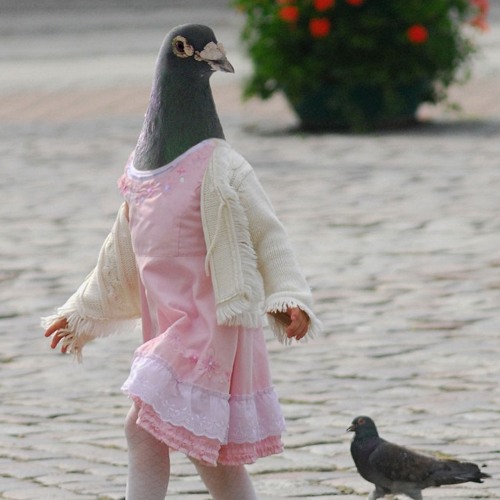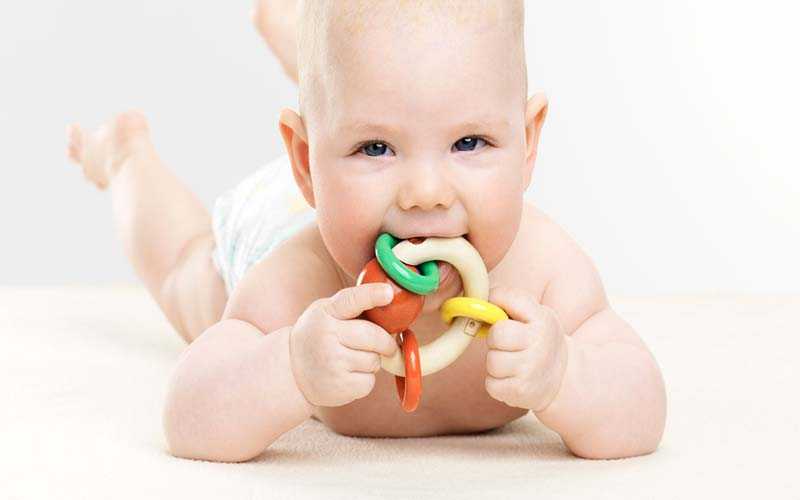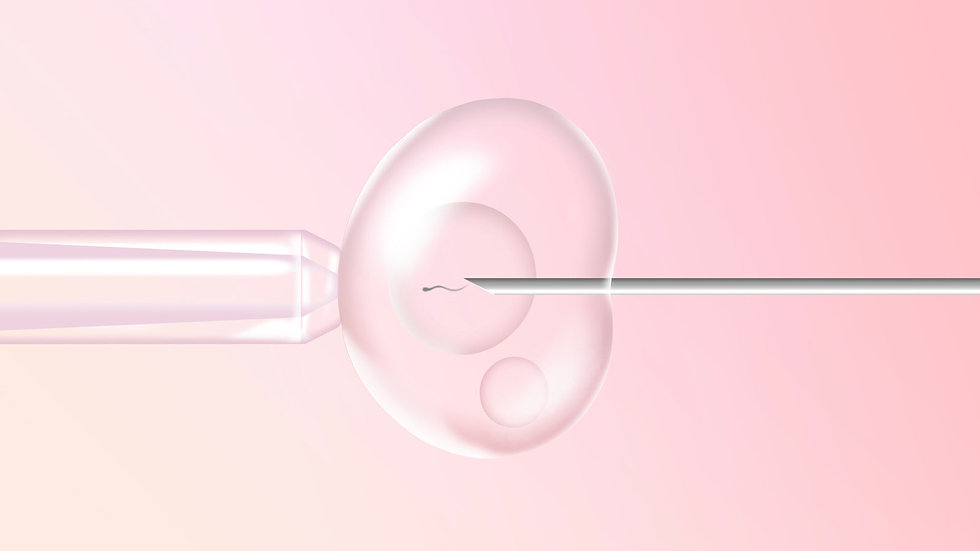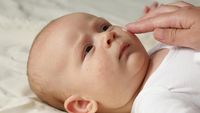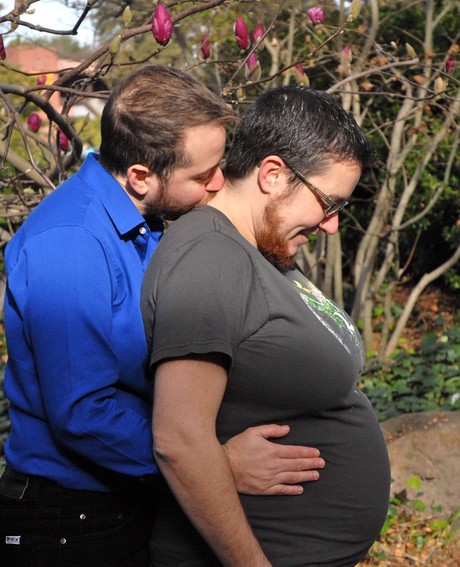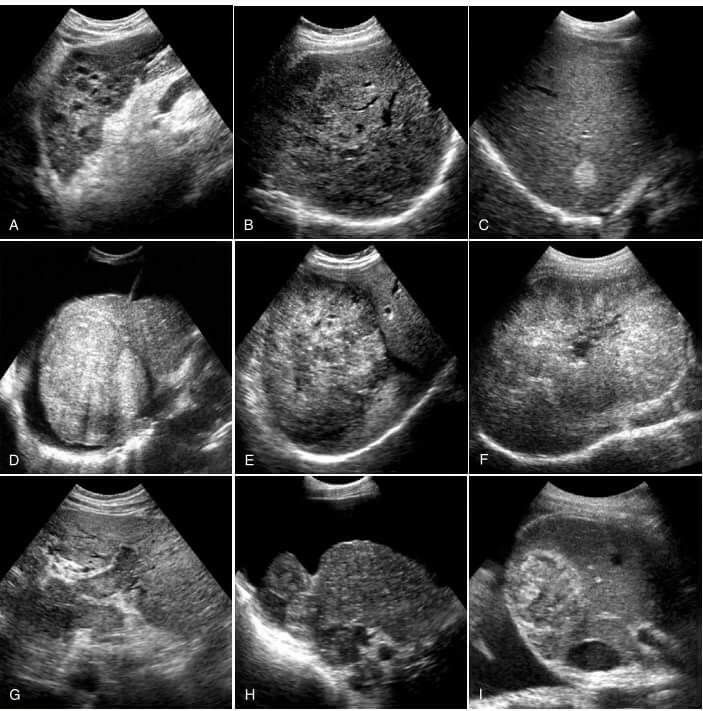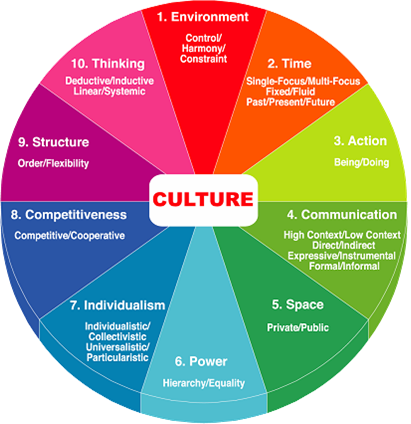How to correct pigeon toed child
My Child is Pigeon Toed: What Should I do?
Seeing a child’s toes point inward may cause a parent concern. However, this common and painless condition, known as pigeon toe or pediatric intoeing, occurs very often in children under the age of 2. It can happen in one or both feet. The condition usually corrects itself with no intervention.
Pigeon toe often develops in the womb or is due to genetic birth defects, so little can be done to prevent it. Contrary to popular belief, there are no known shoes that help prevent pigeon toe and no evidence to suggest that learning to walk in bare feet has any effect on the condition.
Causes of pigeon toe
There are three potential causes of pigeon toe:
Metatarsus varus or metatarsus adductus
In this condition, the foot has a curved, half-moon appearance. The front of the foot is angled in toward the middle of the foot, while the back of the foot and ankle are normal. This type of pigeon toe normally stems from the position the child was in while in the womb.
This type of pigeon toe is fairly common in babies who were breech in utero or whose mothers had less amniotic fluid. In some cases, there may be a family history of the condition.
A doctor is normally able to straighten the foot out once the child is born, and as the child gets older, no further treatment should be required. If desired, a parent can also gently stretch the baby’s feet a few times a day to help correct the shape, though this is not necessary.
Internal tibial torsion
Internal tibial torsion is caused by an inward twisting of the lower leg bone, or the tibia. Initially not noticeable, it often appears about the same time as a child first starts walking.
Children with internal tibial torsion do not usually feel any pain, but parents often report that their child falls frequently. As the child gets older, this type of pigeon toe almost always corrects itself and the child does not normally require any therapy, bracing, or casting.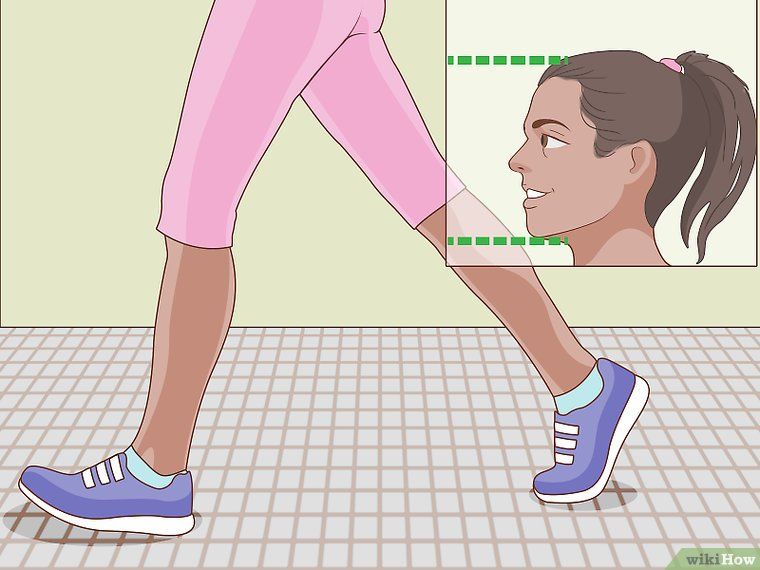
In more severe cases, and if it does not resolve by the time a child reaches 9 or 10 years of age, internal tibial torsion may require surgery to fix it. The procedure involves cutting through the twisted bone and reattaching it to make the foot straighter.
Femoral anteversion
This type of pigeon toe is very common. It affects up 10 percent of children. The upper leg bone, known as the femur, is overly rotated inward in the hip joint. This is due to likely to be caused by stress to the hips before birth.
This type of intoeing normally clears by the age of 8 years. If it continues after this age, an orthopedic surgeon should be consulted to determine if the child needs corrective surgery.
In some cases, children with weaker hip bones may develop pigeon toe. This is more common in girls. Children with weaker muscles and tendons may also develop pigeon toe. However, as a child’s leg and hip muscles naturally get stronger over time, both of these types of pigeon toe tend to disappear.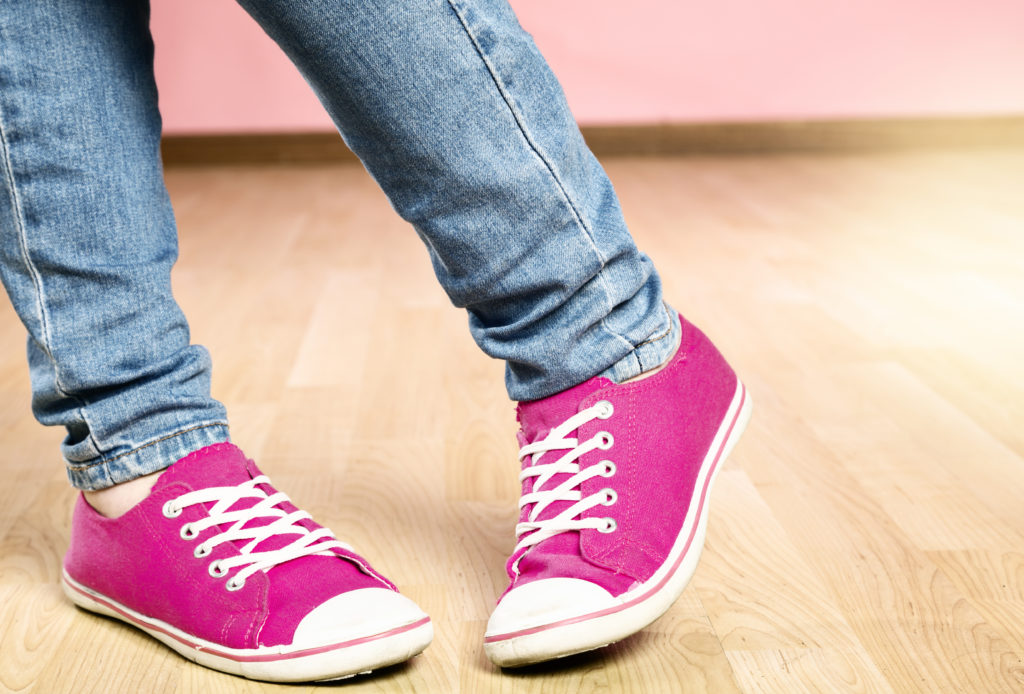
What is pigeon toe like for different age groups?
In pigeon-toed children, the foot and toes often look as if they are pointed inward, but it can look different in children of various ages.
Pigeon toeing may appear as follows:
- Infants: The front of the foot and toes often bend in towards the middle of the foot. The outer part of the baby’s feet will often have a half-moon shape. Mostly, this occurs in both feet.
- Toddlers aged from 1 to 3 years: The pigeon toeing most commonly seen in toddlers is normally the result of tibial torsion where the shinbone is rotated inward. A child in this age group that has pigeon toeing may appear bowlegged.
- Children between 3 and 10 years: Femoral anteversion is the most frequent cause of pigeon toeing in this age group. Children with this often prefer to sit in a “w” position, where their knees appear to go inward.
Pigeon toe presents slightly differently as children start to walk.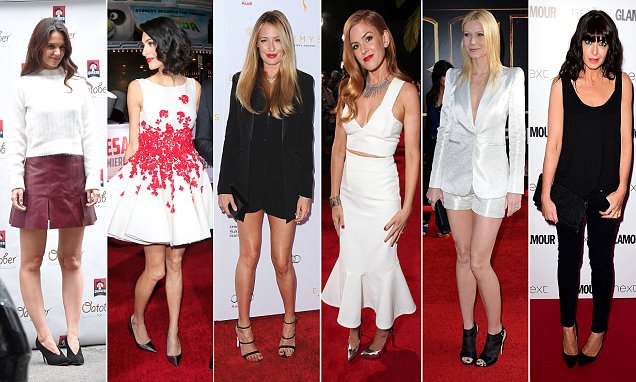 Very often, the cause is due to the leg, not the foot, and the child’s toes appear to point towards each other.
Very often, the cause is due to the leg, not the foot, and the child’s toes appear to point towards each other.
When to see a doctor
There is normally no need to see a doctor right away. However, if pigeon toe is still apparent by the time a child reaches 8 years, or if it causes the child to fall more often than normal, a doctor should be consulted. Most parents seek medical advice regarding pigeon toe as part of their child’s routine exams.
Diagnosis
Diagnosis for pigeon toe depends on the type of pigeon toe a child has. To diagnose the condition, a simple physical exam may be needed. In some cases, X-rays and other imaging may be necessary.
For metatarsus varus or metatarsus adductus, diagnosis could be very early, possibly during the newborn’s post-birth examination. A simple physical examination will be sufficient. The doctor should also rule out issues with the hip that may be the cause.
Internal tibial torsion does not usually appear until the child starts to walk, so the earliest diagnosis may be slightly before 1 year of age. Diagnosis most commonly happens during a physical examination of the infant’s legs. If diagnosed, the doctor will take measurements of the legs.
Diagnosis most commonly happens during a physical examination of the infant’s legs. If diagnosed, the doctor will take measurements of the legs.
Femoral anteversion is most often diagnosed when the child is between the ages of 4-6 years. This will normally start with a physical examination and a review of the medical history of the child and family.
Treating pigeon toe
It is easy to treat most cases of pigeon toe. The most common treatments are time, normal growth, and reassurance. Normally, little or no further intervention is necessary.
If more medical intervention is needed, treatment may include:
- Braces for the legs that slowly correct the position of the bones or feet
- Molds that correct the shape of the foot
- Surgery to correct the positioning of the bones that cause pigeon toe
A doctor or therapist may recommend additional therapies that focus attention on parts of the legs and hips if weakness in those areas may have some impact on the pigeon toe.
Because most cases of pigeon toe resolve on their own over time, most doctors do not recommend much intervention early on. Mostly, they will recommend monitoring and observation.
Are children with pigeon toe able to exercise
Children with pigeon toe can exercise normally and the condition rarely causes any pain. The most common issue is that children with in-turned bones may trip more regularly than other children when exercising. In most cases, simple walking, running, and other natural activities that children do are the best daily exercises.
New Mexico Orthopaedics is a multi-disciplinary orthopedic clinic located in Albuquerque New Mexico. We have multiple physical therapy clinics located throughout the Albuquerque metro area.
New Mexico Orthopaedics offers a full spectrum of services related to orthopedic care and our expertise ranges from acute conditions ó such as sports injuries and fractures ó to prolonged, chronic care diagnoses, including total joint replacement and spinal disorders.
Because our team of highly-trained physicians specialize in various aspects of the musculoskeletal system, our practice has the capacity to treat any orthopedic condition, and offer related support services, such as physical therapy, WorkLink and much more.
If you need orthopedic care in Albuquerque New Mexico contact New Mexico Orthopaedics at 505-724-4300.
Is Your Child Pigeon-Toed? How to Correct…
If you notice that your child’s feet turn inward—usually it becomes apparent once they start walking—this means they’re pigeon-toed. It’s normally a trait that runs in families, so you or another relative may have also been pigeon-toed as a child.
If your little one’s feet point inwards instead of straight ahead, it’s not necessarily a cause for concern. That’s because intoeing (a.k.a. being “pigeon-toed”) is common in babies and young children for a variety of reasons. Tyler W. Christman, DO, a pediatric orthopedic surgeon at Riley Hospital for Children at Indiana University Health, explains some of the most common causes, the specific conditions linked to being pigeon-toed, and treatment options.
Causes & Conditions
If you notice that your child’s feet turn inward—usually it becomes apparent once they start walking—this means they’re pigeon-toed. It’s normally a trait that runs in families, so you or another relative may have also been pigeon-toed as a child. There are three conditions most commonly linked to intoeing.
- The first is called metatarsus adductus or curved foot, which is basically a foot that curves inwards from the middle foot area to the toes and is most common in infants. Severe cases may look like Clubfoot where the whole foot bends inward, but they’re not the same thing.
- Another condition linked to being pigeon-toed is tibial torsion, where the tibia bone in the lower leg turns inward and pulls the foot inward with it. This usually starts when your baby is in utero, because he has to bend his legs inward to fit into the tightening space in the uterus as he grows.
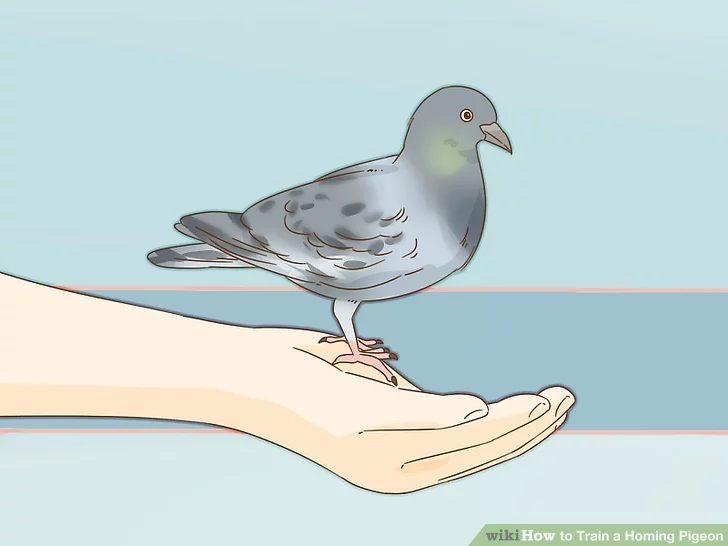 Your child’s legs usually rotate to the proper place after birth, the lower leg bones naturally untwisting as your child’s legs grow longer. You may not notice it until your child begins walking and, in severe cases, trips because of one foot catching on the opposite heel.
Your child’s legs usually rotate to the proper place after birth, the lower leg bones naturally untwisting as your child’s legs grow longer. You may not notice it until your child begins walking and, in severe cases, trips because of one foot catching on the opposite heel.
- The third condition most commonly connected to intoeing is when a twisted upper thigh bone causes the knees and the feet to turn inward when walking, also known as femoral anteversion. This “bow-legged” type appearance goes hand in hand with being pigeon-toed for this condition, and is most noticeable when a child is about five years old. Another clue that your child may be affected is if she often sits with her knees turned inward and feet facing outward in a “W” shape because it’s more comfortable for her to sit that way. “As the deformity corrects, it will become less comfortable and the child will no longer prefer to sit in this position,” says Dr.
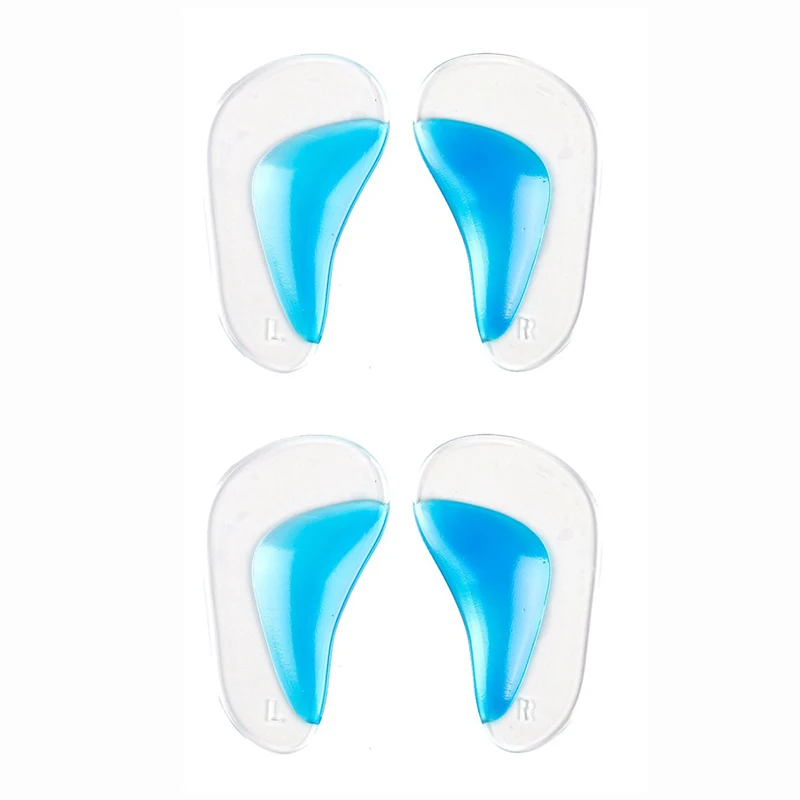 Christman.
Christman.
When to See a Specialist
For most kids, intoeing should correct itself before they turn eight years old, and doesn’t usually require any special treatment. Being pigeon-toed by itself shouldn’t cause your child any pain and it won’t lead to other conditions, such as arthritis. If your child is experiencing pain or has a limp or trouble walking, it may be best to see an orthopedic surgeon for an evaluation.
Treatment Options
- Curved foot: The issue usually takes care of itself by the time your baby is six months old. If your little one still has a severe or particularly rigid curved foot by nine months old, your doctor may recommend casts or special shoes, which are very effective. Surgery isn’t usually needed.
- Twisted shin bone: The tibial torsion rarely requires treatment because the tibia bone usually untwists itself naturally as your child grows taller.
 If, however, tibial torsion remains when your child is around nine or 10 years old and it’s affecting his ability to walk, an orthopedic surgeon may reset the bone with surgery.
If, however, tibial torsion remains when your child is around nine or 10 years old and it’s affecting his ability to walk, an orthopedic surgeon may reset the bone with surgery.
- Twisted upper thigh bone: Studies show that devices such as braces don’t help with femoral anteversion, but, again, it fixes itself in almost all children as they grow. In the rare case that surgery is needed, an orthopedic surgeon may cut the upper thigh bone (femur) to place it in the proper alignment. “This surgery is recommended only in older children with severe rotational deformity in which the intoeing causes the child to frequently trip or fall, or causes severe gait disturbances or problems walking and running,” says Dr. Christman. “Recovery is typically two to three months.”
-- By: Holly C. Corbett
Clubfoot in a child - what is important to know and how to fix?
Since childhood, we know the poem about the bear with a clubfoot. But the problem of clubfoot can occur not only in a bear, but also in Mishka, Seryozhka, Anya, Tanechka and other children, regardless of the name. In this blog post, we will try to figure out what clubfoot is, how to recognize it, and how to fix it.
But the problem of clubfoot can occur not only in a bear, but also in Mishka, Seryozhka, Anya, Tanechka and other children, regardless of the name. In this blog post, we will try to figure out what clubfoot is, how to recognize it, and how to fix it.
This term refers to the deformity of the foot when it deviates inward from the axis of the leg. Simply put, they are turned inward from the leg, although in the normal state they are a direct continuation of it.
Possible causes
Experts divide clubfoot into congenital and acquired. The first can be seen already on ultrasound during pregnancy. The reasons for it are still not exactly known. Perhaps the reason for this is physiology - a narrow uterus that presses on the child, oligohydramnios or breech presentation. There are also opinions that the development of the disease is affected by severe stress or the use of alcohol and drugs during pregnancy. However, a deviation can also occur at the genetic level.
Also, the disease can come after birth. It becomes a consequence of fractures and malunion of bones, growth disorders, burns and tumors. In fairness, we note that such cases are much less common than congenital situations.
It becomes a consequence of fractures and malunion of bones, growth disorders, burns and tumors. In fairness, we note that such cases are much less common than congenital situations.
Depending on the complexity, the disease is divided into three degrees. On the first one, it is often eliminated through manual correction, but on the third, joint mobility is already limited, and treatment with conservative methods is unacceptable.
Diagnosis
Congenital clubfoot is often visible on ultrasound. In the first month of a newborn child's life, he must be examined by pediatricians and an orthopedist. Doctors examine the baby's legs, feel them and, if necessary, write out a referral for an x-ray.
For babies from one year old who have already begun to walk, special attention is paid to the setting of the legs. And it is better to do this unnoticed by the child when he is relaxed or busy playing. The best time is in the morning when the baby splashes in the bath.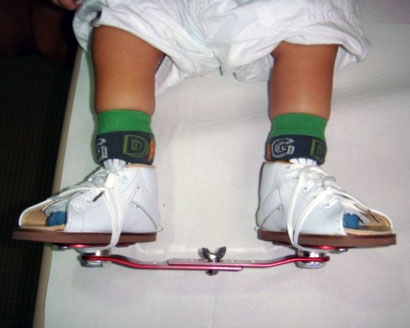 Then he is still usually relaxed and does not control himself.
Then he is still usually relaxed and does not control himself.
Here's what parents should pay attention to:
- foot size - the "sick" foot is usually smaller than the healthy one;
- turn of the feet — in case of illness they seem to be looking at each other;
- footprints (just ask the baby to run with bare wet feet on the sand or tile) - a healthy baby puts his legs parallel to each other and only slightly spreads his toes;
- gait - it should not be heavy, and the legs should not rake the ground.
Conservative treatments
It is best to start treatment already in the first weeks of the baby's life. The tissues are still elastic and pliable, so the correction will happen faster.
The most popular way to correct clubfoot in newborn babies is the Ponseti method. It consists in applying tight plaster bandages from the foot to the upper third of the thigh. In this state, the leg is fixed for 5-7 days, then a new bandage is applied. Usually therapy with plaster takes from 4 to 8 weeks, depending on the severity of the disease.
In this state, the leg is fixed for 5-7 days, then a new bandage is applied. Usually therapy with plaster takes from 4 to 8 weeks, depending on the severity of the disease.
It is also widely used to wear braces - special straps-fixators for the correct abduction of the foot. Boots are attached to this bar. Shoes are put on the baby, and with its help he gets used to the new, correct movement of the legs.
To correct mild to moderate clubfoot, massages, therapeutic exercises and soft bandages are used. In severe cases, only surgery can help.
This is what the brace looks like.
Cunning methods of treatment
It is important for parents to understand that the main acting force in this process is themselves. You can’t give up, you need to motivate the child, monitor the correctness of the procedures.
At the same time, it is also important for a son or daughter to be included in the process. He must know what all these manipulations are for and what they will lead to. Older children should be able to control their own gait.
Older children should be able to control their own gait.
The game process will help here - for example, when you see a white car on the street, you need to look at your legs and, if necessary, correct their setting. Or, if the child made a mistake, it is necessary to wring out five times. I managed to notice the mistake myself - push-ups are canceled.
A dream will be a good motive. What if your son dreams of becoming an astronaut? And clubfoots are hardly taken into space, therefore, if you please, son, still do these exercises.
You can also record lessons and exercises on video, view them together, mark mistakes and inaccurate moments. Children often tend to act in public, so the result is likely to be better when filming a video. And then it comes down to habit.
What to do if a child has a clubfoot
Clubfoot is an anomaly of the anatomical structure of the joints of the foot. Outwardly, it looks like a turn of the foot inward and slightly down.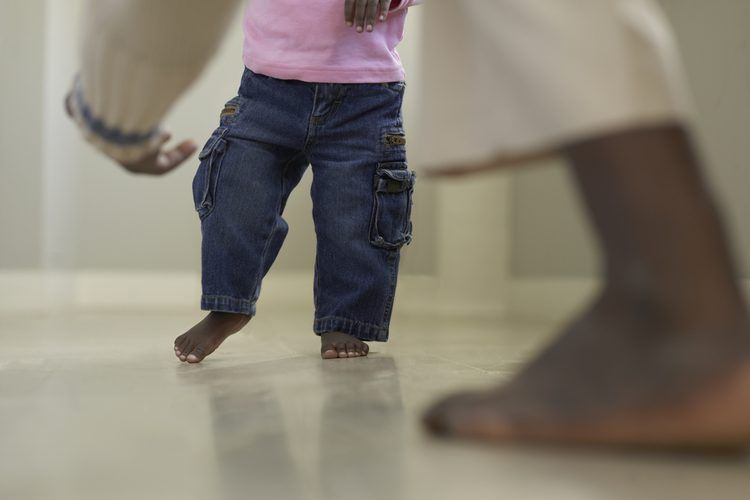 It is impossible to fully step on the foot in this position.
It is impossible to fully step on the foot in this position.
It is important to remember here that there comes a time when clubfoot is no longer amenable to correction. Help the child will no longer be possible. Therefore, treatment should begin immediately after the detection of this deviation.
How to act as a parent with clubfoot in a child - we will tell in our article.
Seeing an orthopedist is the first thing to do
To reduce the level of anxiety and anxiety, it is necessary to make an appointment with an orthopedist.
The doctor will assess the condition of the child's legs and give the necessary recommendations for therapy that can stop the development of pathology.
Frequent advice of orthopedists in the treatment and prevention of the development of clubfoot, as a rule, are:
- massage course;
- certain sports sections that would be useful to visit with such a feature of the anatomical structure - for example, dancing or gymnastics;
- a complex of physiotherapy exercises aimed at eliminating clubfoot;
- home use of massage mats;
- use of orthopedic insoles and/or orthopedic shoes.
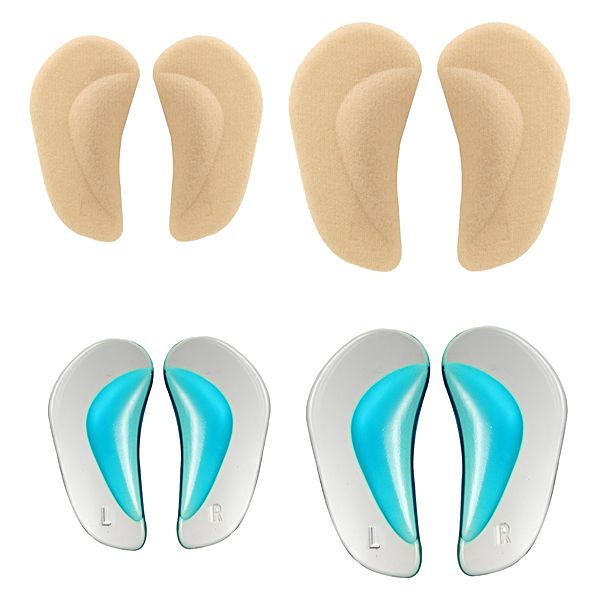
All of the above recommendations are aimed, firstly, at strengthening and stretching the muscles, and secondly, at their activation or relaxation, depending on the prescriptions of the attending orthopedist. Please note that the massage course - its duration and specifics - is prescribed only by a doctor. In the matter of sports, you can choose any discipline, but be sure to pay attention to the traumatic nature of sports. Now it is important to "instruct" the child's body on proper development, so doctors recommend dancing, gymnastics (not an Olympic sport), swimming, etc.
Let us tell you more about those methods of treatment and correction of clubfoot that you can do yourself at home.
Regular gymnastics - exercise therapy for clubfoot
Therapeutic gymnastics for clubfoot aims to strengthen and activate relaxed muscles and, conversely, relax muscles that are in high tone.
When performing these exercises, it is very important for the parent to follow, and the child to try:
- place the foot on the inner arch;
- move the foot towards the little finger.

We will present a set of exercises in the article.
Be sure to coordinate these exercises with your orthopedic doctor!
1. "Rubber". Starting position: sitting on the floor, support with hands behind, straightened legs together. A wide elastic band must be worn on the front sections of the feet.
Take your feet to the sides, stretching the elastic band. The heels remain closed. Try to point your fingers "at yourself", that is, unbend the feet. Hold this tension from ten seconds to one minute - once.
2. "Bar". Starting position: standing with the front sections of the feet on a bar 10-15 cm high, the heels hanging from the bar, with your hands hold on to the crossbar of the Swedish wall or to the back of the chair.
Make springy movements with the heels to the floor, stretching the back surfaces of the legs and the Achilles tendons - three times. Return to starting position. Repeat eight times.
3.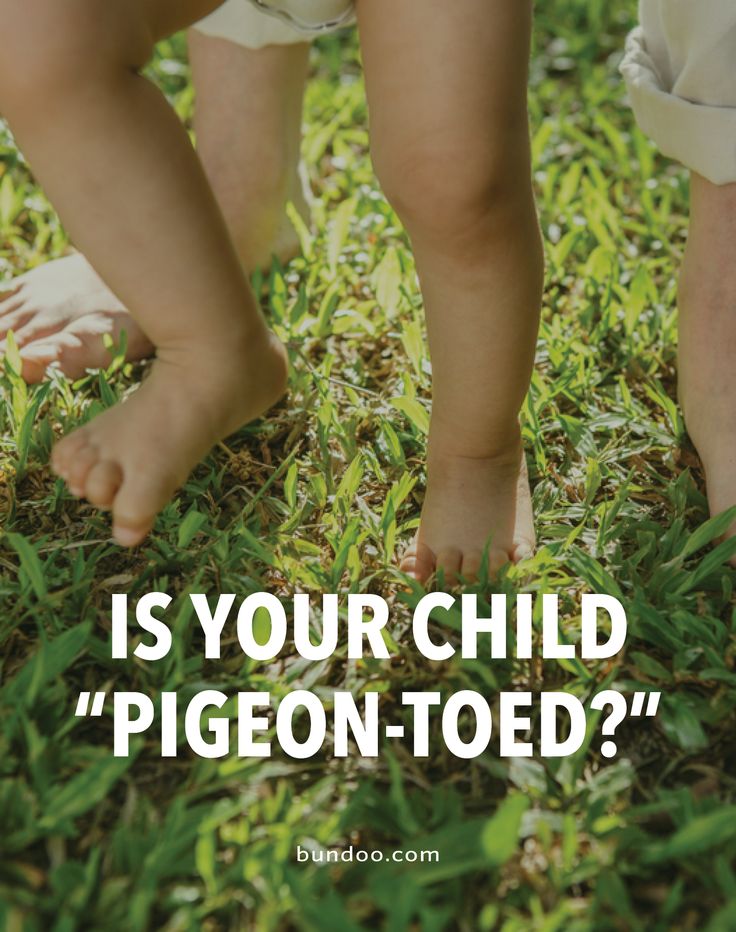 "Herringbone". Starting position: create an image of a straight strip on the mat, from which “branches” go to the sides at an angle, make their frequency equal to the distance of a small step. Rearrange the feet along the “branches” so that the heels are facing the middle, that is, the central strip, and the front sections of the feet are set aside. Here you need to look down to correctly place the feet.
"Herringbone". Starting position: create an image of a straight strip on the mat, from which “branches” go to the sides at an angle, make their frequency equal to the distance of a small step. Rearrange the feet along the “branches” so that the heels are facing the middle, that is, the central strip, and the front sections of the feet are set aside. Here you need to look down to correctly place the feet.
4. "Goose step." Starting position: in a squat position with the feet abducted to the sides. Hands free or on the belt.
Walk to exhaustion.
5. "Walking on your heels." Walk twenty seconds.
6. "Rotation of the foot." Starting position: sitting on a chair, put the right leg on the left knee on the knee, put the hands in the “lock” on the right knee to fix the right leg. With the right foot, “draw” circles clockwise - until slight fatigue. With the left foot, “draw” circles counterclockwise - until slight fatigue.
7. "Rope walker". Walking on a rope or a gymnastic stick with feet abducted to the sides.
Walking on a rope or a gymnastic stick with feet abducted to the sides.
After doing the exercises, relaxing walking is welcome.
There are contraindications. A doctor's consultation is required.
Comprehensive treatment - orthopedic insoles and massage mats
Massage Mat
The massage mat creates the effect of surfaces created by nature that are healthy for the feet. Sand, rocky and forest paths, due to natural irregularities, perfectly massage the bare foot of a person. Massage mats give the same effect.
It is important to understand here that it is difficult or even impossible to make a child walk on a small surface. Therefore, it is best to purchase several rugs and lay them out at home along the child's most frequent route. Thus, throughout the day, the feet will receive a beneficial effect without special efforts on the part of parents and the child.
Orthopedic insoles or shoes
Orthopedic insoles and shoes support the arches of the foot in an anatomically correct position and thus form the correct development of the foot, ankle and knee joints.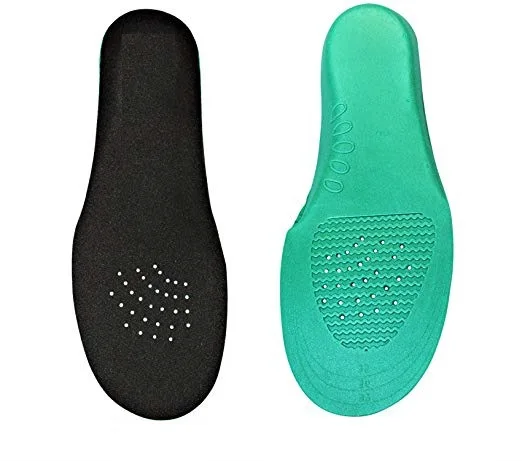 In addition, more comfortable conditions are created for the spine: the likelihood of stoop development is reduced.
In addition, more comfortable conditions are created for the spine: the likelihood of stoop development is reduced.
The necessary insoles or shoes - therapeutic or prophylactic - will be prescribed by an orthopedic doctor. With the recommendations of a doctor, you can already visit a specialized orthopedic salon. It is better to purchase these products in the salon, as in this case there will be a great opportunity to try on and choose what will be most comfortable for the child.
Clubfoot is one of the most severe foot defects. Only a comprehensive treatment of clubfoot, with diligence and conscientious exercise, the use of auxiliary products recommended by the doctor and under the regular supervision of an orthopedist, will give a positive result.
Article editor - Valery Vladimirovich Shevchenko
Head of the training center "Ortix", medical expert in the field of orthopedic products, general practitioner
Back to the list of all articles →See also other sections
| Quote |
|---|
| Hello. How to choose shoes and insoles for varus deformity (Taylor)? |
| Quote |
|---|
| Zhanna wrote:
|
Hello, an orthopedic doctor should prescribe medical shoes for correcting varus deformity in a child. It is necessary to make sure that there are no other complications, inflammatory processes, and only then choose shoes.
In our network of salons there is a pediatric orthopedist, you can make an appointment 8 (800) 777-05-48 for a free appointment and foot diagnostics. You will receive information on the diagnosis, doctor's recommendations, referral for research - if necessary, you can pick up medical shoes on the spot.
Hello, a 4-year-old child was prescribed by an orthopedist to wear a shuster insoles or a preradicular pronator.